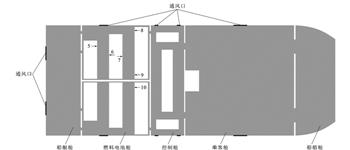| 燃料电池船舶舱内氢气泄漏扩散的数值模拟 |
| |
| 引用本文: | 袁裕鹏, 崔伟逸, 沈辉, 邹智曦, 郭卫勇. 燃料电池船舶舱内氢气泄漏扩散的数值模拟[J]. 交通运输工程学报, 2022, 22(4): 196-209. doi: 10.19818/j.cnki.1671-1637.2022.04.015 |
| |
| 作者姓名: | 袁裕鹏 崔伟逸 沈辉 邹智曦 郭卫勇 |
| |
| 作者单位: | 1.武汉理工大学 交通与物流工程学院,湖北 武汉 430063;;2.武汉理工大学 国家水运安全工程技术研究中心,湖北 武汉 430063;;3.中国远洋海运集团有限公司院士工作站,上海 200135;;4.舟山中远海运重工有限公司,浙江 舟山 316131;;5.武汉船舶职业技术学院 交通运输工程学院,湖北 武汉 430050 |
| |
| 基金项目: | 国家重点研发计划2021YFB2601603 |
| |
| 摘 要: | 
利用FLUENT软件研究了不同条件下氢气在燃料电池船舶舱内的泄漏扩散规律和分布情况; 基于瞬态气体泄漏扩散模型,运用数值模拟方法,建立了船舶舱内氢气泄漏扩散的数值模型,结合影响氢气泄漏扩散的不同因素,对比分析了泄漏位置、泄漏孔径和通风条件等因素对船舶舱内氢气泄漏扩散的影响,得到了不同条件下氢气在船舶舱内的扩散规律和分布情况。
分析结果表明:船舶舱内氢气泄漏扩散过程包括初始喷射、浮力上升和湍流扩散; 燃料电池舱的顶部角落和每排燃料电池发电系统之间的上部是氢气探测报警器的最佳安装位置,不同泄漏条件下氢气均在舱室顶部出现较多积聚; 不同位置和不同孔径泄漏孔的危险性在泄漏初期存在差异,但随着泄漏的持续进行,风险演变规律相近,约60 s后泄漏点附近氢气浓度均接近100%;在燃料电池舱设置防爆型排风机,采用强制抽风措施加快氢气的外排,可以显著减少氢气向其他舱室的扩散,当抽风速度为1 m·s-1时,氢气从燃料电池舱室排放到船舶舷外区域,没有氢气进入控制舱和乘客舱,可有效保障控制舱和乘客舱的安全; 强制送风会加速氢气向船艉舱、控制舱和乘客舱的扩散,增大氢气的扩散范围,加剧了氢气泄漏的危险性。

|
| 关 键 词: | 燃料电池船舶 氢燃料 泄漏 数值模拟 浓度分布 风险预测 |
| 收稿时间: | 2022-02-19 |
|
| 点击此处可从《交通运输工程学报》浏览原始摘要信息 |
|
点击此处可从《交通运输工程学报》下载免费的PDF全文 |
|



